EDU70103 Assignment: Curriculum Foundation, Theories, and Practices
VerifiedAdded on 2023/04/08
|8
|1671
|84
Homework Assignment
AI Summary
This assignment, completed for the Postgraduate Certificate in Teaching and Learning (EDU70103) at Sri Kuala Lumpur, analyzes the curriculum foundation, theories, and practices. The student, Gayathri Annadurai, examines the alignment of the program and subject-level objectives and learning outcomes with the institution's vision and mission. The assignment evaluates the choice of valued learning targets and the clarity and precision (SMART) of the language used in specifying these targets. The student provides a detailed view of the program and subject objectives, focusing on their alignment with the institution's goals. The assignment also includes recommendations for improving the current set of learning outcomes, with justifications for the proposed changes, emphasizing the importance of objectivity in setting targets and assessments. The student suggests practical strategies to enhance the teaching of grammar and tenses. The assignment references the Cambridge Primary (CP) program and relevant literature.
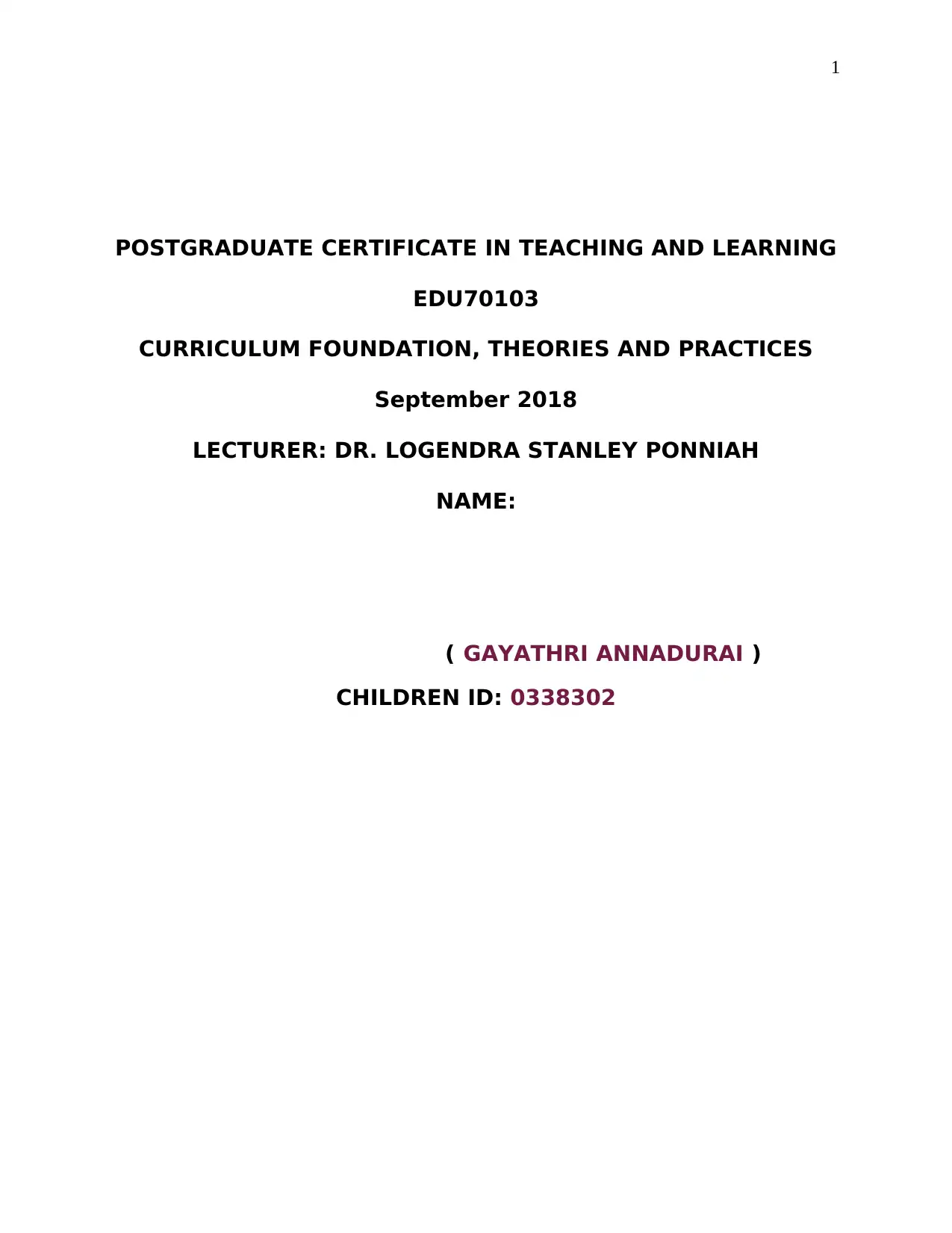
1
POSTGRADUATE CERTIFICATE IN TEACHING AND LEARNING
EDU70103
CURRICULUM FOUNDATION, THEORIES AND PRACTICES
September 2018
LECTURER: DR. LOGENDRA STANLEY PONNIAH
NAME:
( GAYATHRI ANNADURAI )
CHILDREN ID: 0338302
POSTGRADUATE CERTIFICATE IN TEACHING AND LEARNING
EDU70103
CURRICULUM FOUNDATION, THEORIES AND PRACTICES
September 2018
LECTURER: DR. LOGENDRA STANLEY PONNIAH
NAME:
( GAYATHRI ANNADURAI )
CHILDREN ID: 0338302
Paraphrase This Document
Need a fresh take? Get an instant paraphrase of this document with our AI Paraphraser

2
2. View of the objective and the learning outcomes of the programme
The alignment with the institutional vision and mission
From my point of view, the objectives and learning outcomes of the program are in line
with the institution’s vision and mission. The ability of the school to provide a high quality of
education by initiating the program that fulfills Malaysian educational aspirations has
transformed Sri Kuala Lumpur to be an outstanding institution providing excellent quality of
education that prepares the children to face the emerging challenges in 21st century. In addition,
with the school anchored to the Cambridge Primary (CP) programme, the professionally trained
teachers have provided academic assistance to the children making them sociable happy,
enthusiastic, and excited about joining the primary schools. In addition, the children’s mind is
emotionally prepared to face any form of challenge they are likely to experience when they join
high school. Furthermore, the professionals have transformed the children to be highly proficient
in language and numeric skills, confident in public speaking and creative that is in line with Sri
Kuala Lumpur’s mission of “developing children to their full potential and imbue them with
healthy habits of mind, tenacity of spirit and morals anchors to become effective individuals and
responsible citizens”.
The choice of the set of valued learning targeted.
In terms of the choice of the set of value learning targeted, the objectives and learning
outcomes significantly impacts the learning goals. The set targets are in line with objectives
clearing showing what the children are expected to do or know at the end of the programme. For
example, the value-learning target of making children understand all concepts taught in classes
and apply them is in line with objective and learning outcome of producing creative children
2. View of the objective and the learning outcomes of the programme
The alignment with the institutional vision and mission
From my point of view, the objectives and learning outcomes of the program are in line
with the institution’s vision and mission. The ability of the school to provide a high quality of
education by initiating the program that fulfills Malaysian educational aspirations has
transformed Sri Kuala Lumpur to be an outstanding institution providing excellent quality of
education that prepares the children to face the emerging challenges in 21st century. In addition,
with the school anchored to the Cambridge Primary (CP) programme, the professionally trained
teachers have provided academic assistance to the children making them sociable happy,
enthusiastic, and excited about joining the primary schools. In addition, the children’s mind is
emotionally prepared to face any form of challenge they are likely to experience when they join
high school. Furthermore, the professionals have transformed the children to be highly proficient
in language and numeric skills, confident in public speaking and creative that is in line with Sri
Kuala Lumpur’s mission of “developing children to their full potential and imbue them with
healthy habits of mind, tenacity of spirit and morals anchors to become effective individuals and
responsible citizens”.
The choice of the set of valued learning targeted.
In terms of the choice of the set of value learning targeted, the objectives and learning
outcomes significantly impacts the learning goals. The set targets are in line with objectives
clearing showing what the children are expected to do or know at the end of the programme. For
example, the value-learning target of making children understand all concepts taught in classes
and apply them is in line with objective and learning outcome of producing creative children
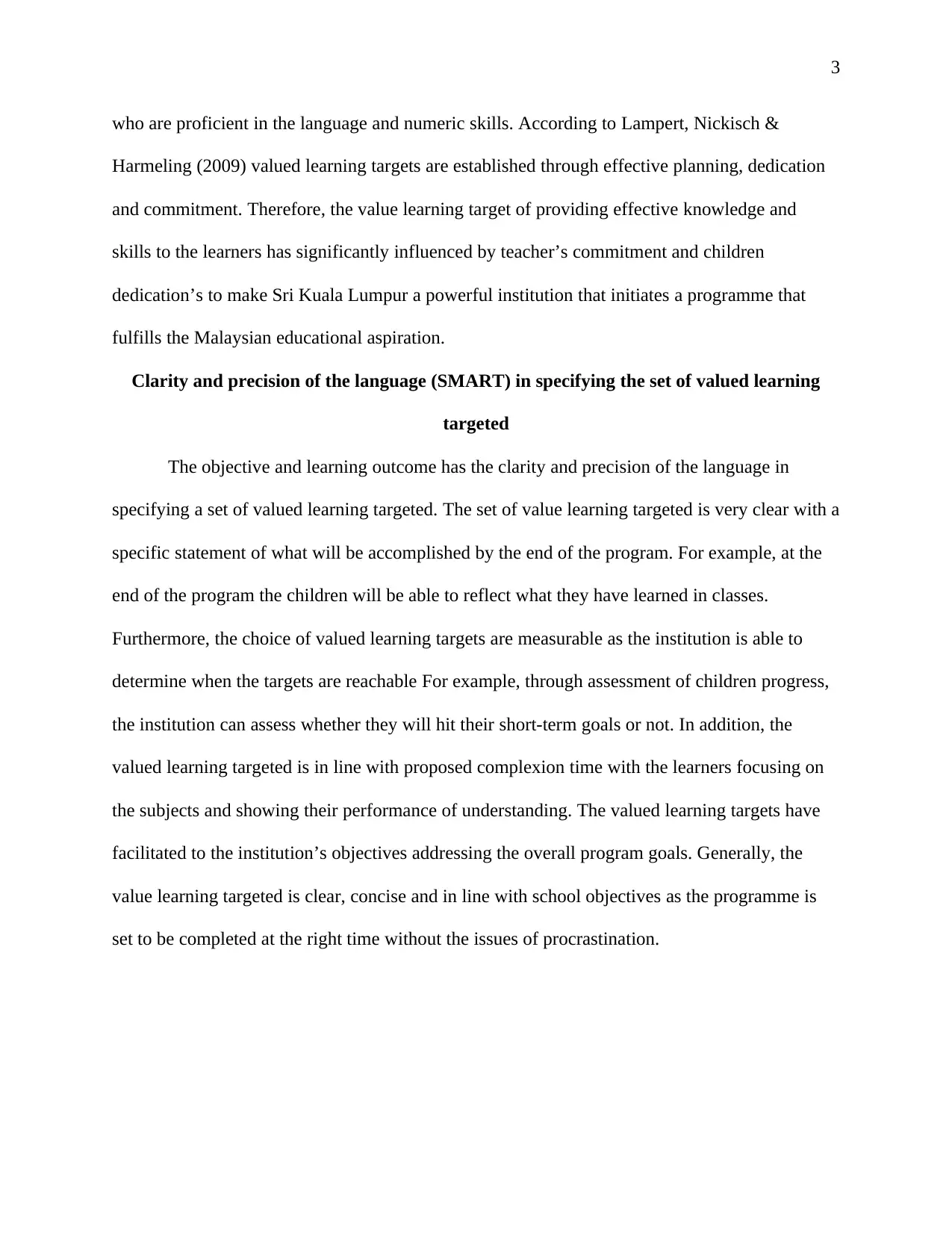
3
who are proficient in the language and numeric skills. According to Lampert, Nickisch &
Harmeling (2009) valued learning targets are established through effective planning, dedication
and commitment. Therefore, the value learning target of providing effective knowledge and
skills to the learners has significantly influenced by teacher’s commitment and children
dedication’s to make Sri Kuala Lumpur a powerful institution that initiates a programme that
fulfills the Malaysian educational aspiration.
Clarity and precision of the language (SMART) in specifying the set of valued learning
targeted
The objective and learning outcome has the clarity and precision of the language in
specifying a set of valued learning targeted. The set of value learning targeted is very clear with a
specific statement of what will be accomplished by the end of the program. For example, at the
end of the program the children will be able to reflect what they have learned in classes.
Furthermore, the choice of valued learning targets are measurable as the institution is able to
determine when the targets are reachable For example, through assessment of children progress,
the institution can assess whether they will hit their short-term goals or not. In addition, the
valued learning targeted is in line with proposed complexion time with the learners focusing on
the subjects and showing their performance of understanding. The valued learning targets have
facilitated to the institution’s objectives addressing the overall program goals. Generally, the
value learning targeted is clear, concise and in line with school objectives as the programme is
set to be completed at the right time without the issues of procrastination.
who are proficient in the language and numeric skills. According to Lampert, Nickisch &
Harmeling (2009) valued learning targets are established through effective planning, dedication
and commitment. Therefore, the value learning target of providing effective knowledge and
skills to the learners has significantly influenced by teacher’s commitment and children
dedication’s to make Sri Kuala Lumpur a powerful institution that initiates a programme that
fulfills the Malaysian educational aspiration.
Clarity and precision of the language (SMART) in specifying the set of valued learning
targeted
The objective and learning outcome has the clarity and precision of the language in
specifying a set of valued learning targeted. The set of value learning targeted is very clear with a
specific statement of what will be accomplished by the end of the program. For example, at the
end of the program the children will be able to reflect what they have learned in classes.
Furthermore, the choice of valued learning targets are measurable as the institution is able to
determine when the targets are reachable For example, through assessment of children progress,
the institution can assess whether they will hit their short-term goals or not. In addition, the
valued learning targeted is in line with proposed complexion time with the learners focusing on
the subjects and showing their performance of understanding. The valued learning targets have
facilitated to the institution’s objectives addressing the overall program goals. Generally, the
value learning targeted is clear, concise and in line with school objectives as the programme is
set to be completed at the right time without the issues of procrastination.
⊘ This is a preview!⊘
Do you want full access?
Subscribe today to unlock all pages.

Trusted by 1+ million students worldwide
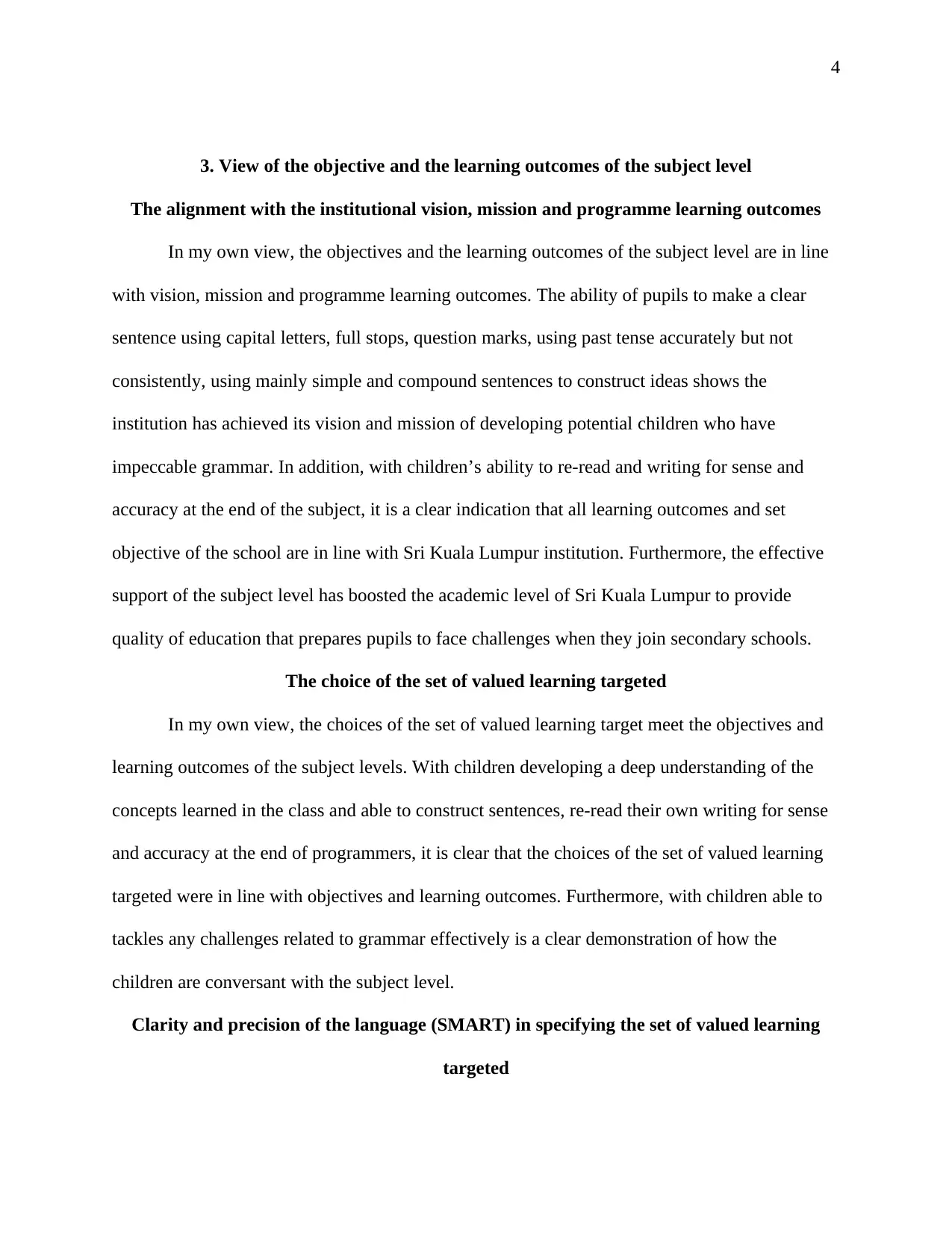
4
3. View of the objective and the learning outcomes of the subject level
The alignment with the institutional vision, mission and programme learning outcomes
In my own view, the objectives and the learning outcomes of the subject level are in line
with vision, mission and programme learning outcomes. The ability of pupils to make a clear
sentence using capital letters, full stops, question marks, using past tense accurately but not
consistently, using mainly simple and compound sentences to construct ideas shows the
institution has achieved its vision and mission of developing potential children who have
impeccable grammar. In addition, with children’s ability to re-read and writing for sense and
accuracy at the end of the subject, it is a clear indication that all learning outcomes and set
objective of the school are in line with Sri Kuala Lumpur institution. Furthermore, the effective
support of the subject level has boosted the academic level of Sri Kuala Lumpur to provide
quality of education that prepares pupils to face challenges when they join secondary schools.
The choice of the set of valued learning targeted
In my own view, the choices of the set of valued learning target meet the objectives and
learning outcomes of the subject levels. With children developing a deep understanding of the
concepts learned in the class and able to construct sentences, re-read their own writing for sense
and accuracy at the end of programmers, it is clear that the choices of the set of valued learning
targeted were in line with objectives and learning outcomes. Furthermore, with children able to
tackles any challenges related to grammar effectively is a clear demonstration of how the
children are conversant with the subject level.
Clarity and precision of the language (SMART) in specifying the set of valued learning
targeted
3. View of the objective and the learning outcomes of the subject level
The alignment with the institutional vision, mission and programme learning outcomes
In my own view, the objectives and the learning outcomes of the subject level are in line
with vision, mission and programme learning outcomes. The ability of pupils to make a clear
sentence using capital letters, full stops, question marks, using past tense accurately but not
consistently, using mainly simple and compound sentences to construct ideas shows the
institution has achieved its vision and mission of developing potential children who have
impeccable grammar. In addition, with children’s ability to re-read and writing for sense and
accuracy at the end of the subject, it is a clear indication that all learning outcomes and set
objective of the school are in line with Sri Kuala Lumpur institution. Furthermore, the effective
support of the subject level has boosted the academic level of Sri Kuala Lumpur to provide
quality of education that prepares pupils to face challenges when they join secondary schools.
The choice of the set of valued learning targeted
In my own view, the choices of the set of valued learning target meet the objectives and
learning outcomes of the subject levels. With children developing a deep understanding of the
concepts learned in the class and able to construct sentences, re-read their own writing for sense
and accuracy at the end of programmers, it is clear that the choices of the set of valued learning
targeted were in line with objectives and learning outcomes. Furthermore, with children able to
tackles any challenges related to grammar effectively is a clear demonstration of how the
children are conversant with the subject level.
Clarity and precision of the language (SMART) in specifying the set of valued learning
targeted
Paraphrase This Document
Need a fresh take? Get an instant paraphrase of this document with our AI Paraphraser
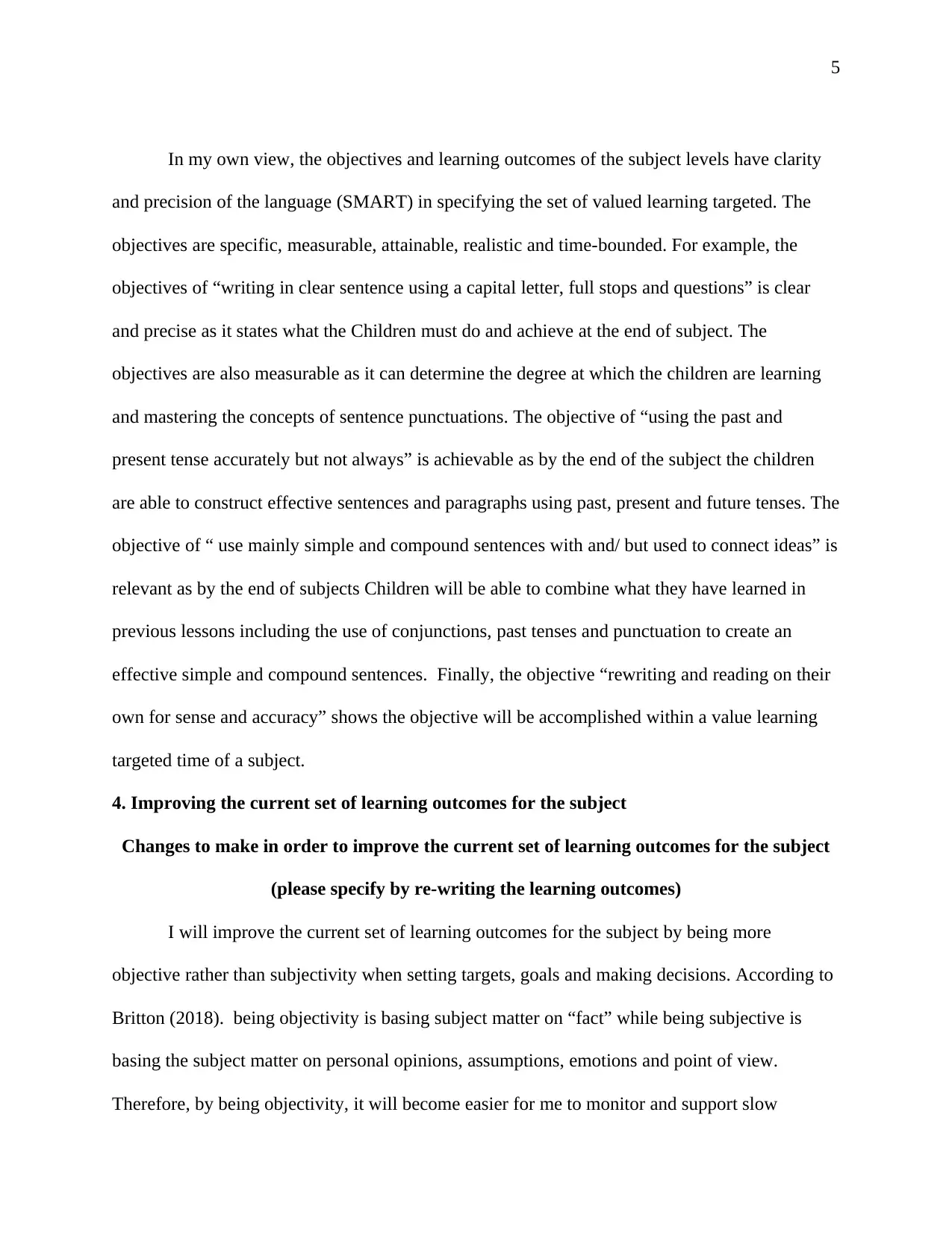
5
In my own view, the objectives and learning outcomes of the subject levels have clarity
and precision of the language (SMART) in specifying the set of valued learning targeted. The
objectives are specific, measurable, attainable, realistic and time-bounded. For example, the
objectives of “writing in clear sentence using a capital letter, full stops and questions” is clear
and precise as it states what the Children must do and achieve at the end of subject. The
objectives are also measurable as it can determine the degree at which the children are learning
and mastering the concepts of sentence punctuations. The objective of “using the past and
present tense accurately but not always” is achievable as by the end of the subject the children
are able to construct effective sentences and paragraphs using past, present and future tenses. The
objective of “ use mainly simple and compound sentences with and/ but used to connect ideas” is
relevant as by the end of subjects Children will be able to combine what they have learned in
previous lessons including the use of conjunctions, past tenses and punctuation to create an
effective simple and compound sentences. Finally, the objective “rewriting and reading on their
own for sense and accuracy” shows the objective will be accomplished within a value learning
targeted time of a subject.
4. Improving the current set of learning outcomes for the subject
Changes to make in order to improve the current set of learning outcomes for the subject
(please specify by re-writing the learning outcomes)
I will improve the current set of learning outcomes for the subject by being more
objective rather than subjectivity when setting targets, goals and making decisions. According to
Britton (2018). being objectivity is basing subject matter on “fact” while being subjective is
basing the subject matter on personal opinions, assumptions, emotions and point of view.
Therefore, by being objectivity, it will become easier for me to monitor and support slow
In my own view, the objectives and learning outcomes of the subject levels have clarity
and precision of the language (SMART) in specifying the set of valued learning targeted. The
objectives are specific, measurable, attainable, realistic and time-bounded. For example, the
objectives of “writing in clear sentence using a capital letter, full stops and questions” is clear
and precise as it states what the Children must do and achieve at the end of subject. The
objectives are also measurable as it can determine the degree at which the children are learning
and mastering the concepts of sentence punctuations. The objective of “using the past and
present tense accurately but not always” is achievable as by the end of the subject the children
are able to construct effective sentences and paragraphs using past, present and future tenses. The
objective of “ use mainly simple and compound sentences with and/ but used to connect ideas” is
relevant as by the end of subjects Children will be able to combine what they have learned in
previous lessons including the use of conjunctions, past tenses and punctuation to create an
effective simple and compound sentences. Finally, the objective “rewriting and reading on their
own for sense and accuracy” shows the objective will be accomplished within a value learning
targeted time of a subject.
4. Improving the current set of learning outcomes for the subject
Changes to make in order to improve the current set of learning outcomes for the subject
(please specify by re-writing the learning outcomes)
I will improve the current set of learning outcomes for the subject by being more
objective rather than subjectivity when setting targets, goals and making decisions. According to
Britton (2018). being objectivity is basing subject matter on “fact” while being subjective is
basing the subject matter on personal opinions, assumptions, emotions and point of view.
Therefore, by being objectivity, it will become easier for me to monitor and support slow
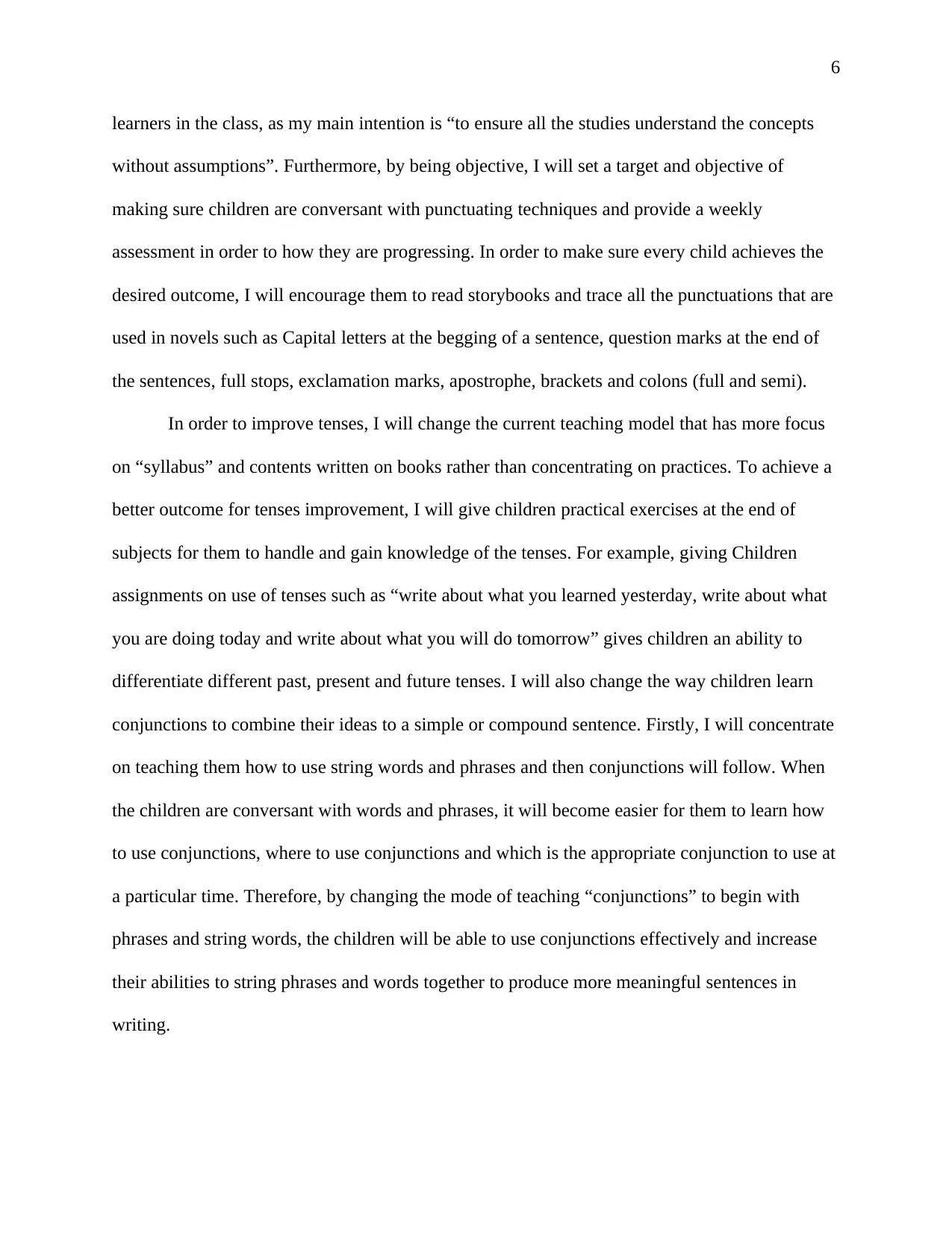
6
learners in the class, as my main intention is “to ensure all the studies understand the concepts
without assumptions”. Furthermore, by being objective, I will set a target and objective of
making sure children are conversant with punctuating techniques and provide a weekly
assessment in order to how they are progressing. In order to make sure every child achieves the
desired outcome, I will encourage them to read storybooks and trace all the punctuations that are
used in novels such as Capital letters at the begging of a sentence, question marks at the end of
the sentences, full stops, exclamation marks, apostrophe, brackets and colons (full and semi).
In order to improve tenses, I will change the current teaching model that has more focus
on “syllabus” and contents written on books rather than concentrating on practices. To achieve a
better outcome for tenses improvement, I will give children practical exercises at the end of
subjects for them to handle and gain knowledge of the tenses. For example, giving Children
assignments on use of tenses such as “write about what you learned yesterday, write about what
you are doing today and write about what you will do tomorrow” gives children an ability to
differentiate different past, present and future tenses. I will also change the way children learn
conjunctions to combine their ideas to a simple or compound sentence. Firstly, I will concentrate
on teaching them how to use string words and phrases and then conjunctions will follow. When
the children are conversant with words and phrases, it will become easier for them to learn how
to use conjunctions, where to use conjunctions and which is the appropriate conjunction to use at
a particular time. Therefore, by changing the mode of teaching “conjunctions” to begin with
phrases and string words, the children will be able to use conjunctions effectively and increase
their abilities to string phrases and words together to produce more meaningful sentences in
writing.
learners in the class, as my main intention is “to ensure all the studies understand the concepts
without assumptions”. Furthermore, by being objective, I will set a target and objective of
making sure children are conversant with punctuating techniques and provide a weekly
assessment in order to how they are progressing. In order to make sure every child achieves the
desired outcome, I will encourage them to read storybooks and trace all the punctuations that are
used in novels such as Capital letters at the begging of a sentence, question marks at the end of
the sentences, full stops, exclamation marks, apostrophe, brackets and colons (full and semi).
In order to improve tenses, I will change the current teaching model that has more focus
on “syllabus” and contents written on books rather than concentrating on practices. To achieve a
better outcome for tenses improvement, I will give children practical exercises at the end of
subjects for them to handle and gain knowledge of the tenses. For example, giving Children
assignments on use of tenses such as “write about what you learned yesterday, write about what
you are doing today and write about what you will do tomorrow” gives children an ability to
differentiate different past, present and future tenses. I will also change the way children learn
conjunctions to combine their ideas to a simple or compound sentence. Firstly, I will concentrate
on teaching them how to use string words and phrases and then conjunctions will follow. When
the children are conversant with words and phrases, it will become easier for them to learn how
to use conjunctions, where to use conjunctions and which is the appropriate conjunction to use at
a particular time. Therefore, by changing the mode of teaching “conjunctions” to begin with
phrases and string words, the children will be able to use conjunctions effectively and increase
their abilities to string phrases and words together to produce more meaningful sentences in
writing.
⊘ This is a preview!⊘
Do you want full access?
Subscribe today to unlock all pages.

Trusted by 1+ million students worldwide
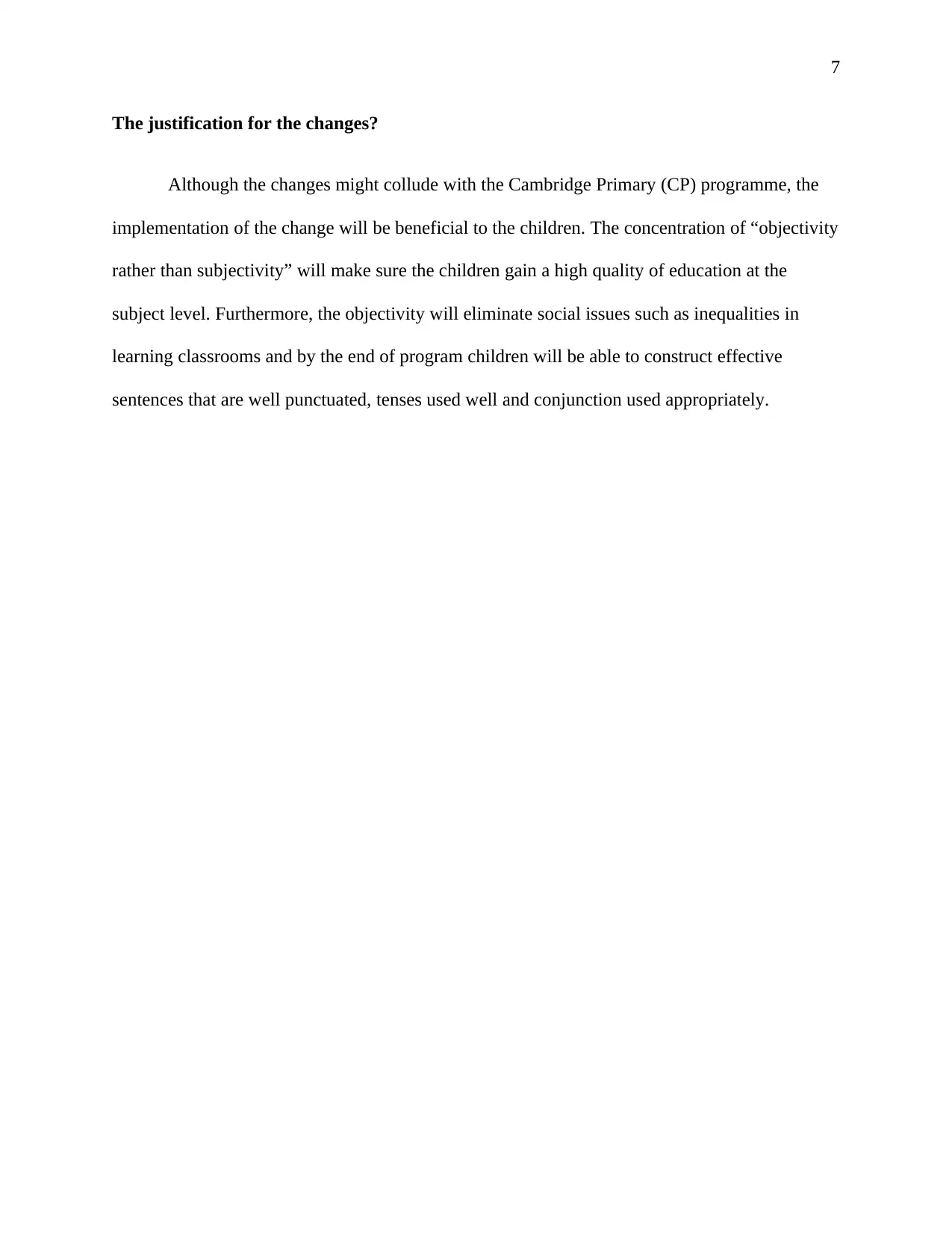
7
The justification for the changes?
Although the changes might collude with the Cambridge Primary (CP) programme, the
implementation of the change will be beneficial to the children. The concentration of “objectivity
rather than subjectivity” will make sure the children gain a high quality of education at the
subject level. Furthermore, the objectivity will eliminate social issues such as inequalities in
learning classrooms and by the end of program children will be able to construct effective
sentences that are well punctuated, tenses used well and conjunction used appropriately.
The justification for the changes?
Although the changes might collude with the Cambridge Primary (CP) programme, the
implementation of the change will be beneficial to the children. The concentration of “objectivity
rather than subjectivity” will make sure the children gain a high quality of education at the
subject level. Furthermore, the objectivity will eliminate social issues such as inequalities in
learning classrooms and by the end of program children will be able to construct effective
sentences that are well punctuated, tenses used well and conjunction used appropriately.
Paraphrase This Document
Need a fresh take? Get an instant paraphrase of this document with our AI Paraphraser

8
References
Britton, R. (2018). Subjectivity, objectivity, and triangular space. In Mapping Psychic Reality
(pp. 91-104). Routledge.
Lampert, C. H., Nickisch, H., & Harmeling, S. (2009, June). Learning to detect unseen object
classes by between-class attribute transfer. In 2009 IEEE Conference on Computer
Vision and Pattern Recognition (pp. 951-958). IEEE.
References
Britton, R. (2018). Subjectivity, objectivity, and triangular space. In Mapping Psychic Reality
(pp. 91-104). Routledge.
Lampert, C. H., Nickisch, H., & Harmeling, S. (2009, June). Learning to detect unseen object
classes by between-class attribute transfer. In 2009 IEEE Conference on Computer
Vision and Pattern Recognition (pp. 951-958). IEEE.
1 out of 8
Your All-in-One AI-Powered Toolkit for Academic Success.
+13062052269
info@desklib.com
Available 24*7 on WhatsApp / Email
![[object Object]](/_next/static/media/star-bottom.7253800d.svg)
Unlock your academic potential
Copyright © 2020–2025 A2Z Services. All Rights Reserved. Developed and managed by ZUCOL.

